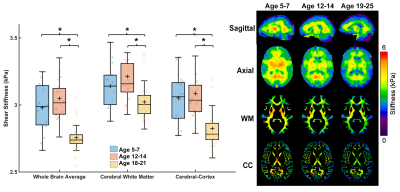Grace McIlvain 1, Julie M Schneider2, Melanie A Matyi 3, Melissa S DiFabio1, Peyton L Delgorio1, Matthew DJ McGarry 4, Jeffrey M Spielberg3, Zhenghan Qi2, and Curtis L Johnson1
1Biomedical Engineering, University of Delaware, Newark, DE, United States, 2Department of Linguistics, University of Delaware, Newark, DE, United States, 3Department of Psychology, University of Delaware, Newark, DE, United States, 4Thayer School of Engineering, Dartmouth College, Hanover, NH, United States
1Biomedical Engineering, University of Delaware, Newark, DE, United States, 2Department of Linguistics, University of Delaware, Newark, DE, United States, 3Department of Psychology, University of Delaware, Newark, DE, United States, 4Thayer School of Engineering, Dartmouth College, Hanover, NH, United States
Brain mechanical properties measured through MR elastography have not been comprehensively studied in the pediatric population. Here we report notable maturational related regional differences in brain stiffness and damping ratio in people ages 5-21.

Bar chart displays group viscoelastic shear stiffness values in three groups for the whole brain, the cerebral white matter and the cerebral cortex, with significance difference between groups indicated with * (p < 0.05). Stiffness maps were registered to the MNI standard space template and averaged across subjects of same age group.

Bar chart displays group viscoelastic shear stiffness values in three groups for the subcortical grey matter structures including the amygdala, hippocampus, caudate, putamen, pallidum and thalamus, with significance difference between groups indicated with * (p < 0.05). Stiffness maps were registered to the MNI standard space template and averaged across subjects of same age group.
